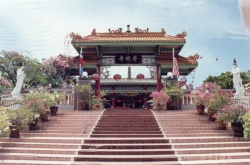Difference between revisions of "King Suchandra"
(Redirected page to Suchandra) |
(Removed redirect to Suchandra) Tag: Removed redirect |
||
| Line 1: | Line 1: | ||
| − | + | {{DisplayImages|32}} | |
| + | |||
| + | |||
| + | |||
| + | |||
| + | |||
| + | |||
| + | |||
| + | |||
| + | There is little recorded about the history of [[Shambhala]] prior to [[Suchandra]]. We are told the names of his father and mother, [[Suryaprabha]] and [[Vijaya]], and that the dynasty of Shambhala belongs to the same [[Shakya]] line into which [[Shakyamuni Buddha]] was born, but that is about all. However, later events will show that the religion of [[Shambhala]] prior to [[Suchandra’s]] introduction of the [[Kalachakra]] belonged to the [[Indian]] [[Vedic tradition]]. | ||
| + | |||
| + | [[King Suchandra]], like King [[Indrabhuti]] of [[Uddiyana]], was an emanation of the tenth-stage [[bodhisattva]] [[Vajrapani]]. This is significant because [[Vajrapani]] is the chief redactor of the [[Vajrayana teachings]]. [[Vajrapani]] and his various emanations serve as the intermediaries between the [[Buddha]] and ordinary human beings in the transmission of the [[Vajrayana]] doctrines. | ||
| + | |||
| + | After the [[Buddha]] taught the [[Paramadibuddha]] at [[Dhanyakataka]], [[Suchandra]] and his satraps returned to [[Shambhala]], as mentioned above. [[Suchandra]] then composed a sixty thousand line commentary on the [[Paramadibuddha]] using the language of [[Shambhala]]. | ||
| + | |||
| + | Having erected the great [[Kalachakra mandala]] south of [[Kalapa]], [[Suchandra]] offered [[initiation]] into, and explanation of, the [[Kalachakra]] system to the residents of the 960 million villages of [[Shambhala]]. | ||
| + | |||
| + | Those who liked these teachings listened to them, recited them, memorized them, and in turn gave them to others. In the second year after he taught the [[tantra]], [[Suchandra]] manifested various miraculous phenomena. Then, using an enjoyment body ([[sambhogakaya]]), he returned to the place his emanation body ([[nirmanakaya]]) had come from, as a cause for [[sentient beings]]’ [[siddhis]] (attainments). | ||
| + | |||
| + | |||
| + | see also:[[Suchandra]] | ||
| + | |||
| + | |||
| + | |||
| + | |||
| + | |||
| + | {{E}} | ||
| + | [[Category:Kings of Shambhala]] | ||
Latest revision as of 22:35, 14 July 2019
There is little recorded about the history of Shambhala prior to Suchandra. We are told the names of his father and mother, Suryaprabha and Vijaya, and that the dynasty of Shambhala belongs to the same Shakya line into which Shakyamuni Buddha was born, but that is about all. However, later events will show that the religion of Shambhala prior to Suchandra’s introduction of the Kalachakra belonged to the Indian Vedic tradition.
King Suchandra, like King Indrabhuti of Uddiyana, was an emanation of the tenth-stage bodhisattva Vajrapani. This is significant because Vajrapani is the chief redactor of the Vajrayana teachings. Vajrapani and his various emanations serve as the intermediaries between the Buddha and ordinary human beings in the transmission of the Vajrayana doctrines.
After the Buddha taught the Paramadibuddha at Dhanyakataka, Suchandra and his satraps returned to Shambhala, as mentioned above. Suchandra then composed a sixty thousand line commentary on the Paramadibuddha using the language of Shambhala.
Having erected the great Kalachakra mandala south of Kalapa, Suchandra offered initiation into, and explanation of, the Kalachakra system to the residents of the 960 million villages of Shambhala.
Those who liked these teachings listened to them, recited them, memorized them, and in turn gave them to others. In the second year after he taught the tantra, Suchandra manifested various miraculous phenomena. Then, using an enjoyment body (sambhogakaya), he returned to the place his emanation body (nirmanakaya) had come from, as a cause for sentient beings’ siddhis (attainments).
see also:Suchandra
